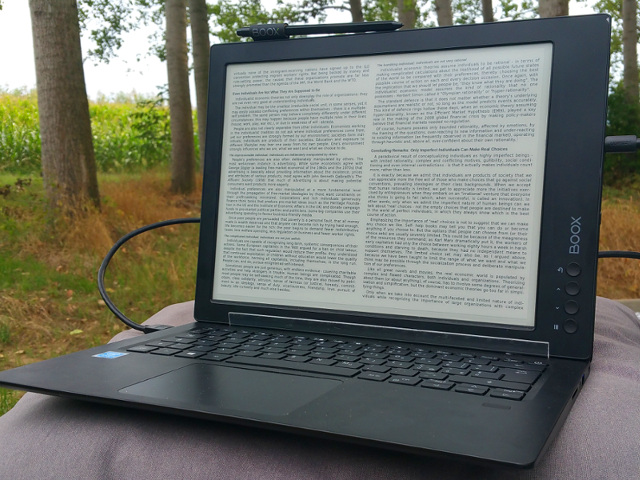On this beautiful day I tested for the first time the Max2 used as monitor, through the HDMI connection, with a recent laptop. The experiment came from the fact that these days are being so extremely bright, several layers of shaders have proved barely enough for screen content visibility on the original laptop. (And it has been cloudy. Let's say it is so luminous that the laptop display, at zero brightness - with the back-lighting switched off -, showed content. The laptop display became reflective tech just owing to environmental light... In the shade. I kid you not.)
The setup per se was excellent. The laptop uses a recent Pentium Silver N5000 CPU, which allows for a fan-less light device which can last over 12 hours with a single charge (and embedding a light battery). I cut a strip of plexiglass - which was, curiously enough, a leftover of the production of a protective sheet for the Max2 sleeve - that can be inserted in the gap at the laptop hinge to keep the tablet in place. The Max2 almost perfectly matches the laptop lid in width. It became immediately evident that the matte screen used by Onyx is relatively very good: it gives much less reflection than the matte screen of the laptop.
The software setup was also smooth as Sade. I worked on a text on LibreOffice viewed through my latest Mod of the Monitor application from Onyx. Immediately I noticed that the incorrect resolution imposed by Onyx was not a problem: the document text was rendered better than on the laptop itself, owing to the 60% bigger resolution (the wrong-resolution-related blur only affects the GUI elements, and on the document text it just makes it smoother). Document pages set at 21x31cm with thin margins, a keyboard shortcut set to center the double-page box in the screen at will (especially on EPD you will want things as statically in place as possible): productivity had been there with little left to be desired.
...Actually, what left to be desired in the work system is the touchscreen. I did not use the feature that we coded with Sogaiu, because it implies connecting the USB, which implies draining the laptop's battery, which is nonsense. A way to connect USB for data exchange without powering the tablet is still very, very, very much needed. There would be a simple software solution (a flag on Android does disable USB charge) - which requires root privileges. Which Onyx, last time I checked, had not given...
While I could work very well, the problem encountered was with the Max2 battery: after 4 hours, it was depleted. It seems that even though the screen updates very, very rarely, or in small chunks (of course I was using Greyscale Update mode, not A2, and GU is conservative in the dot switch, while A2 with F-S dithering is a mess), the tablet drains battery fast in the background. It appears that the HDMI data is processed continuously, without optimization.
Of course, it would be nice to see if VNC behaves more properly, energy wise. Of course, it is just theoretical because you would want to use VNC without charging the tablet and draining the laptop, exactly as per the paragraph above...
Switching to a more traditional set-up as the Max2 was at 2% battery, I could see that the set-up was worthwhile as the laptop display at maximum brightness (and in the shade of trees and more) appeared still less contrasted than the EPD screen, two hours before sunset. So, confirmedly, reflective technology remains a definite gain outdoors, even considering just the visual effect (disregarding matters like energy use).
